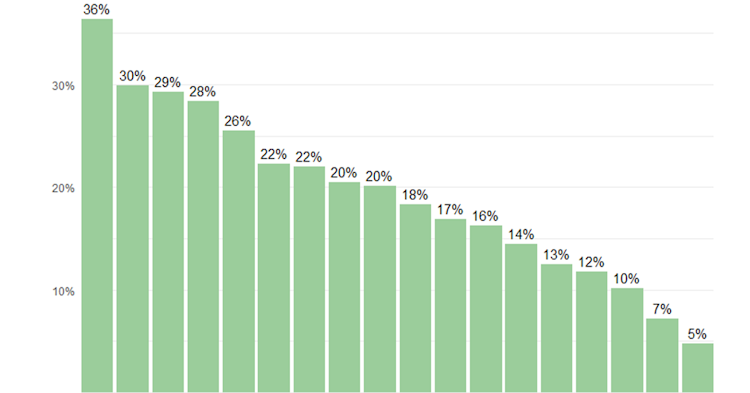The AFL Draft: How Afraid Should Clubs Be Of The 'Go-Home' Factor?
Last updated: Dec 7, 2020, 12:26AM | Published: Dec 6, 2020, 9:13PM
The AFL draft is a funny time of year.
Right now my football club (and yours) is busy preparing to make decisions that I have no control over, and that – compared to those who spend their careers working on such things – I know very little about.
Despite this, I have strong opinions about what those decisions should be. And I know I’m not alone.
As a North Melbourne fan particularly, pick 2 is the earliest the club has selected in the draft in nearly 20 years, and debate rages among fans as to the best use of it.
One of the most common concerns I’ve seen when talking about players like Western Australia’s Logan McDonald or South Australia’s Riley Thilthorpe is this: will they stay, if drafted to Victoria? Or could they go home?
This is a discussion that seems to pop up every year- it's the AFL’s infamous “go-home” factor. But is it as big of a factor as we often fear? Today, we’ll take a look at the numbers and try to answer that question.
For data, we’re looking at every player drafted from 2000-present who was taken in the national draft and was being drafted for the first time – we’ll break down where they came, where they went, whether they were traded, and if so, to where.
For the purposes of brevity, please know that moving clubs as a free agent or as an expansion concession signing (ie Tom Scully to GWS, Gary Ablett to Gold Coast) will be counted as being ‘traded’ in the numbers we’re talking about here.
There’s a significant caveat that comes with this approach: many of the players we’re talking about are still in the midst of their AFL careers. Many of those who have not been traded eventually will move clubs.
So, keep in mind for context that these are living numbers. They will change and re-shape themselves as time goes on.
RELATED: AFL Draft 2020: How Is Your Club Positioned?
Let’s start with the draft. Potential draftees are often asked how they’d feel about moving interstate, and some – like Will Phillips recently – are openly honest about the fact they’d prefer to remain home. But how many get to?
The short answer is that 48% - roughly half – of all players get drafted to their home state. But this can of course differ significantly depending on what state they originate from.
Draftees hailing from Victoria are the most likely to stay home with 65% remaining in Victoria – on the other hand, prospect from WA and SA are a long shot, with 26% and 23% respectively drafted to their home states.
NSW and Queensland are of course shaped by AFL academies. Since 2013, when the first academy player was selected, 60% of Queenslanders have stayed home as have a whopping 88% of NSW draftees.
At first glance that may seem like a huge advantage for clubs in those states – but further consideration is warranted.

The fact is, so few players are produced by either of those states that it doesn’t make much a dent in the numbers, and the four northern-states clubs are comfortably last in the chart above, which shows the percentage of draftees to each club that are remaining in their home state.
RELATED: AFL Trade Period 2020: What The Numbers Say About Your Club’s Performance
The fairness of the price to pay and the overall bid-matching system are probably mechanisms that need some improvement, but the basic philosophy of trying to direct as much NSW and Queensland talent to clubs in their home states make sense, given what a systemic disadvantage those clubs are at.
The other team that really stands out here is West Coast, who compared to similarly positioned sides Port Adelaide, Adelaide and Fremantle have taken a significantly higher proportion of their draftees from their home state.
Maybe that’s a wise strategy, because the numbers suggest there is some truth to the go-home factor.
28% of players drafted interstate in the time period we’re looking at have eventually been traded out, compared to only 17% of players who are drafted to stay in their home state.
72% of all trade moves involve a move across state borders, and roughly half of these take the form of a player returning home after being drafted interstate.
Breaking it down by state, Victorians have the highest attrition rate. 25% of Victorians drafted interstate in this time have eventually been traded home – while WA, SA, NSW and Queensland are all somewhere around the 10-15%mark.
Interstate draftees, too, are more likely to seek a trade early. The average seasons before trade for them is 5.3, while for those who are drafted to their home state, it’s 6.4.

Which clubs are the hardest hit? The above graph shows for each AFL club what percentage of their drafted players have eventually been traded out of the club.
It’s not a surprise to see GWS at the top of the charts – what’s more surprising, perhaps, is to see Geelong, Hawthorn and Sydney as the three clubs that follow.
They have probably been the most consistently successful clubs of this era, and not ones we would think of as having retention issues – but it’s important to consider the different circumstances trades happen under.
Many of these trades could be successful veterans who move on to another club late in their careers, such as Steve Johnson’s move to GWS, or fringe players at a strong team who seek greater opportunity elsewhere, like Jed Anderson’strade to North Melbourne.
Essendon, North Melbourne and Carlton at the other end of the chart have lost few if any players over the last 20 years, but have also been some of the most mediocre clubs of that time period. Perhaps it suggests a certain amount of trade turnover is part of success, even healthy.
That puts GWS’ numbers in a better light – and perhaps explains why the AFL’s other expansion club, Gold Coast, is in the middle of the pack rather than way out in front.
Keeping in mind that we’re only looking at draftees and not-pre-listed players, the Suns have lost just 10 to GWS’ 25 in roughly the same period of time. But, this is not the only way to measure the impact on clubs.

This chart is a little more complex. It takes the career AFLCA votes awarded to each draftee in the 2000-present time period and calculates what percentage of each club’s draftee’s votes were won at clubs other than that which they were drafted to.
For example, 36% of the coaches votes won by players drafted to Brisbane in the past 20 years have been recorded after moving to a new club. Elliot Yeo has won all of his 256 career coaches votes since moving to the West Coast Eagles.
By this measure, both the Giants and Suns are close to the top. Joining them and the Lions in the top four is Adelaide who have lost players like Patrick Dangerfield, who picked up 315 votes as a Crow and so far has 465 as a Cat.
Some of the differences between this chart and the previous are stark. For example Geelong’s numbers in particular look much healthier than before, and Hawthorn and Sydney have improved noticeably too.
On the other hand, while Carlton had one of the best retention rates in the previous chart, it’s clear that the players who have left have often been quality, pushing them into top six for highest percentage of votes lost.
North Melbourne on the other hand look like one of the AFL’s great retainers by either measure, and Richmond’s ability to keep their best talent at the club also deserves some recognition.
West Coast’s case just gets all the more curious – in the previous chart it could be noted that they are losing only 17% of draftees to trade, lower than their fellow WA and SA clubs, and perhaps a vindication of their home-state drafting policy.
But by this measure they’re essentially in the middle of that pack, leaving it debatable just how much of a positive effect that strategy is having on their ability to retain top-tier talent.
RELATED: Which AFL Clubs Actually Have The Best Young Talent?
CLOSING THOUGHTS
The numbers make it clear that the go-home factor is a genuine phenomenon. Taking a draftee from interstate is always riskier than taking a local boy – and given the demographics of where AFL draftees come from, this disadvantages come clubs more than others.
That said, the fear often expressed that an interstate draftee might immediately return home is probably exaggerated.
Only 4% of draftees are traded within two seasons of being drafted – while there are some noteworthy exceptions, the vast majority show some loyalty beyond that initial contract even if it does mean staying interstate.
Some clubs have struggled more with retention than others. The identities of those clubs aren’t surprising – the Giants, Suns, Lions and Crows have all been hit hard by the go-home factor at times.
But there are some success stories. Brisbane certainly seem to have turned it around, and teams like Port Adelaide and Fremantle in particular are showing an impressive ability to keep players at the club- even though they take around 70%of their players from interstate.
Circling back to the very beginning of this piece, I’d say North Melbourne in particular should feel confident picking an interstate talent at pick 2, if they believe that player is the best one to add to their list.
The Kangaroos have often be criticised in recent years for failing to convince their trade targets to come to the club – but the numbers make it pretty clear that they do very well at getting draftees to stay.
Did you enjoy this article? Join our free mailing list to get the best content delivered straight to your inbox, or join the conversation by leaving a comment below or on the Stats Insider Twitter or Facebook page.



